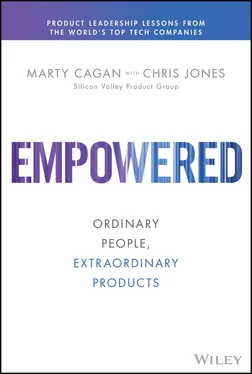If you have an HR function at your company, they are there to support managers with these activities, but they are in no way a substitute for the manager in these responsibilities.
Probably the single most important, yet most often overlooked, element to capable management is coaching. At the very minimum, this involves a weekly 1:1 with the people who report to you as their people manager.
It is the most important responsibility of every people manager to develop the skills of their people. This most definitely does not mean micromanaging them. It does mean understanding their weaknesses and helping them to improve, providing guidance on lessons learned, removing obstacles, and what is loosely referred to as “connecting the dots.”
For example, let's say you are the manager of product design, and you meet each week for an hour or so with each of the six product designers from six different product teams that work for you.
These six product designers are each first‐class members of their cross‐functional product teams (because design is a first‐class activity, and as such it needs to partner closely with the product manager and engineers as they tackle and solve hard problems). But even if that designer is exceptionally skilled, how can she be expected to keep track of what is going on with all the other product teams? What if the design she is working on right now for her situation is in some way inconsistent or incompatible with solutions underway with other teams? The design manager is expected to flag these conflicts and get the relevant designers together to consider the bigger picture and the impact of the different solutions on the user.
More generally, every member of a product team deserves to have someone who is committed to helping them get better at their craft. This is why, in the vast majority of strong tech product organizations, the engineers report to experienced engineering managers; the designers report to experienced design managers; and the product managers report to proven managers of product management.
The third responsibility of the people managers is to ensure that each product team has one or two clear objectives they have been assigned (typically quarterly) which spell out the problems they are being asked to solve.
These objectives derive directly from the product strategy—it's where insights are turned into actions.
This is also where empowerment becomes real and not just a buzzword. The team is given a small number of significant problems to solve (the team objectives).
The team considers the problems and proposes clear measures of success (the key results), which they then discuss with their managers. The managers may need to iterate with their teams and others to try and get as much coverage as possible of the broader organization's objectives.
The litmus test for empowerment is that the team is able to decide the best way to solve the problems they have been assigned (the objectives).
It takes strong managers to be self‐confident and secure enough to truly empower the people that work for them, and to stand back and let the team take credit for their successes.
1 1 In this book I refer to the role of product design, and the title product designer. Many companies use the terms user experience design or customer experience design. What's important is that I am including service design, interaction design, visual design, and, for devices, industrial design.
CHAPTER 4
Empowered Product Teams
What is most surprising to me is that the virtues of truly empowered product teams are not a secret. In fact, there are plenty of books and articles out there that describe why these types of teams are so much more effective at innovation and in solving hard problems.
While quite a few these books are inspiring and well worth reading, most companies have not been convinced to empower their teams in any meaningful sense. Why is that?
When I ask this question of CEOs and other key leaders of these organizations, the answer typically boils down to one word: trust .
The leaders don't trust the teams. Specifically, they don't believe they have the level of people on their teams they need to truly empower them. So, along with the other key business leaders from across the company, they believe they need to very explicitly direct the teams themselves. This is also known as the “command‐and‐control” model of management.
When I ask these leaders why they don't put people in place that they do trust, they usually argue that they either can't find, can't afford, or can't attract the level of people that Google, Amazon, Apple, and Netflix hire.
I then point out to them the many people I know who have moved from companies like theirs to one of these leading companies, and how their performance dramatically improved in the process.
And further, having worked with many people at each of these companies, I point out how ordinary the vast majority of the people on these teams actually are. Maybe the important difference lies elsewhere?
Maybe these strong companies have different views on how to leverage their talent in order to help their ordinary people reach their true potential and create, together, extraordinary products.
CHAPTER 5
Leadership in Action
This book argues that the key to building strong product companies is having strong product leaders.
After all, these are the people responsible for staffing and coaching the members of the product teams, and they are responsible for the product vision, principles, and especially the product strategy, which determines the specific problems we need product teams to solve.
So, what do these strong product leaders look like? And what are they like to work for?
In INSPIRED , I profiled six product managers who were all responsible for iconic products, yet were largely unknown, and I told their stories—including the challenges they faced and how they overcame them.
In EMPOWERED , I want to do the same, but this time with product leaders. I profile here eight product leaders. Each has had an exceptional career at iconic product companies. Yet again, most of them are largely unknown.
I highlight two leaders of product management, two leaders of product design, two leaders of engineering, and two leaders of companies.
I'm not trying to provide full biographies here, but rather, I asked them each to share, in their own words, their journeys to leadership. My hope is that their words will give you a good sense of their approach to leadership, and most of all, what it is like to work with and for a strong and experienced product leader.
CHAPTER 6
A Guide to EMPOWERED
Who This Book Is For
This book is intended for anyone interested in creating a strong product organization—from a startup founder to the CEO of a major technology‐powered company.
Specifically, the book is aimed at product leaders and aspiring product leaders . Especially the leaders of product managers, product designers, and engineers.
When you see a reference to “product person,” that is normally anyone in product management, product design, or engineering. The person might be an individual contributor or a manager.
While there are many other roles you may find within a given product team—delivery manager, user researcher, data analyst, data scientist, and product marketing manager being the main ones—this book focuses on the three core roles of product manager (PM), product designer (designer), and engineering tech lead (tech lead).
Читать дальше











